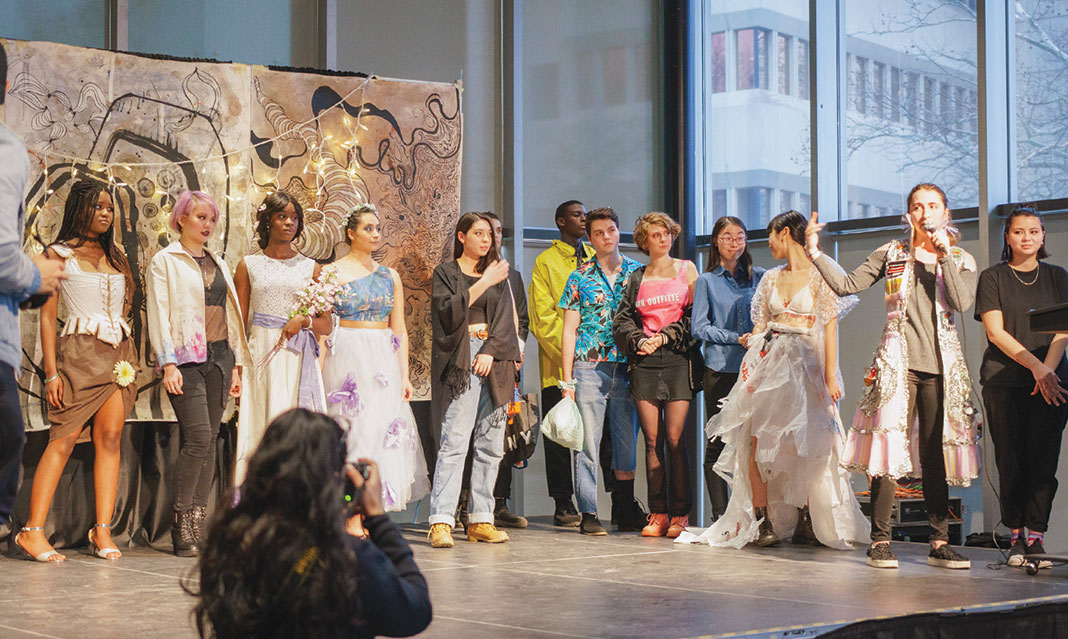On March 15, the UTMSU, Creatives For A Change, Zero Waste UTM, and Style & Profyle organized UTM’s first ever Trashion Show. The event was held at the Blind Duck’s Pub and had an amazing turn out of energetic audience members, patiently waiting to view the designs created for the night. The clubs got together to host an event that will bring awareness to environmental sustainability through the use of fashion and art. The event showcased the upcycling of used clothing and items that typically go into the trash, to prompt conservation by illustrating how people can reduce, reuse, and recycle in the art world. The event had two parts of the show: the Arts and the Runway.
The Art Section of the evening included an exhibition of different artworks, ranging from paintings to sculptures and clothing. Artists promoted awareness for sustainability in their compositions by depicting animal extinction, landfill waste, and climate change. One piece in particular was a sleeveless cardigan made completely of straws and pop cans. Colourful straws made up majority of the cardigan, meanwhile all parts of pop cans were used to add décor. Also, in the middle of the runway, a sculpture made of trash was created with the use of actual garbage found in UTM dumpsters.
The Runway portion of the event consisted of designers and their models who showcased their creations. The designers incorporated plastic bags, used fabric, bubble wrap, and other materials to create their pieces. The outfits for the evening consisted of different styles, ranging from casual wear, to grunge and boho, to business attire. The clothing was environmentally focused and consisted of a variety of colours and patterns such as: animal texture, florals, and nature-themed. The designers were judged by professionals in the fashion business who filled out score cards to pick a winner.
The winner of the Runway section was Justine Lyn. She won a subscription to C Magazine and a $100 prepaid Visa gift card. Lyn designed 8 outfits using unconventional and scrap fabric that would have ended in the trash otherwise. One outfit in particular that Lyn designed was reused canvas with the painting of a blue, purple, and pink peacock on the back. The jacket was paired with black pants, a sheer black top, and black bra. Lyn’s designs showcased that fashion can come from what is already owned; using old fabric can create a new and unique look, which helps reduce the amount of material thrown into landfills.
The runner up was Chelsea Dalton, who designed a colourful bodycon dress made of old t-shirts that were cut into strips and knitted together. The dress took approximately one month to complete and was created through the collaboration of participants in the Green Ambassador Program. Dalton’s design was a low-thigh, sleeveless dress, with horizontal blocks of bright colours and thick tank-top straps. Dalton’s colourful dress presented that creativity can come from being environmentally friendly, as the only purchase she had to make was a circular bamboo knitting needle.
Another creation, which received a cheering reaction from the crowd, was an a-line, high-low, white skirt, completely made of plastic bags. The skirt was paired with a cream triangle laced bralette and a bubble wrap bolero. The plastic bags were all white with the exception of store logos that were printed on. The designer created an eccentric piece using materials which are not typically seen as fashionable.
All pieces were themed around sustainability by bringing awareness to the environment through art. Each artist incorporated the message of caring for the environment in their designs. The event advocated for change and hopes that everyone can make small differences to better the ecosystem. When small differences come together, they make large impacts on Earth, preserving and allowing the planet to flourish.



